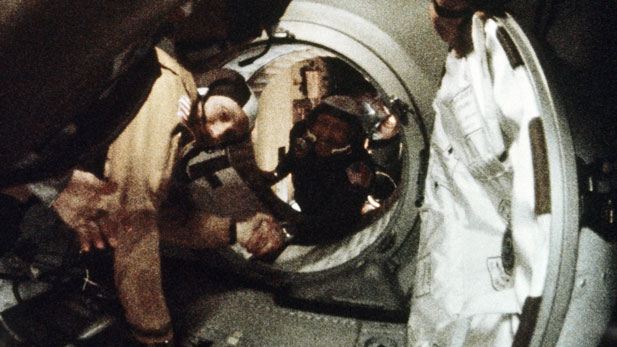 Astronaut Tom Stafford (left) and cosmonaut Alexey Leonov shake hands after the first docking of U.S. and Soviet spacecraft in 1975.
Astronaut Tom Stafford (left) and cosmonaut Alexey Leonov shake hands after the first docking of U.S. and Soviet spacecraft in 1975.By Russell Lewis | NPR
Tom Stafford, one of NASA's early astronauts, who flew in space four times including a trip to orbit the moon and then a historic rendezvous with Soviet cosmonauts, has died. He was 93 and passed away on Monday after battling a long illness.
NASA Administrator Bill Nelson said on X, the social media platform formerly known as Twitter, "Today General Tom Stafford went to the eternal heavens which he so courageously explored as a Gemini and Apollo astronaut as well as a peacemaker in Apollo Soyuz. Those of us privileged to know him are very sad but grateful we knew a giant."
Stafford was born in Weatherford, Okla., in 1930 and later recalled, "As a little boy I wanted to fly airplanes and then later, be a fighter pilot. I wanted to go higher and faster. And [space] was just the next logical step."
Stafford graduated from the U.S. Naval Academy and then was a test pilot in the Air Force. NASA selected him in 1962 as part of the second group of the space agency's astronauts.
He flew in space aboard Gemini 6 and then on Gemini 9. He commanded Apollo 10 in 1969, the second time NASA orbited the moon. That was the dress rehearsal before NASA's first landing on the moon two months later. Stafford, along with Gene Cernan, flew the lunar module to within nine miles of the surface before eventually returning to Earth.
In Stafford's final trip to space in 1975, he and two crewmates flew an Apollo spacecraft and rendezvoused with a Soviet Soyuz capsule. The event was marked with photos of Stafford and cosmonaut Alexey Leonov shaking hands where the two craft were joined.
The Apollo-Soyuz Test Project flight was the first joint mission and was followed by others aboard the Mir and International Space Stations.
Before this mission, Stafford spent two years learning Russian and traveling to Moscow. He told NPR in 2016, the mission was important because it ended the space race. "We proved that two countries with different languages, differing units of measurement, certainly vastly different political systems could work together to achieve a common goal," he said.
Stafford left NASA after that flight and eventually retired from the Air Force as a lieutenant general. Later, he complained that after Apollo NASA needed a clear mandate for its explorations. "Have a consistent strategy and goal and stay with it and don't change with administrations," he said. "Like you don't start building an aircraft carrier and stop when the [new] administration comes."
Throughout his life, Stafford said he was driven by the principles "study hard and work hard. ... Remember it's your attitude not your aptitude that will take you to the highest altitude in your life."
Stafford is the third Apollo-era astronaut to die in the past four months (Frank Borman and Ken Mattingly). There are just eight remaining astronauts still alive from the lunar program.
Brendan Byrne of member station WMFE contributed this report.

By submitting your comments, you hereby give AZPM the right to post your comments and potentially use them in any other form of media operated by this institution.